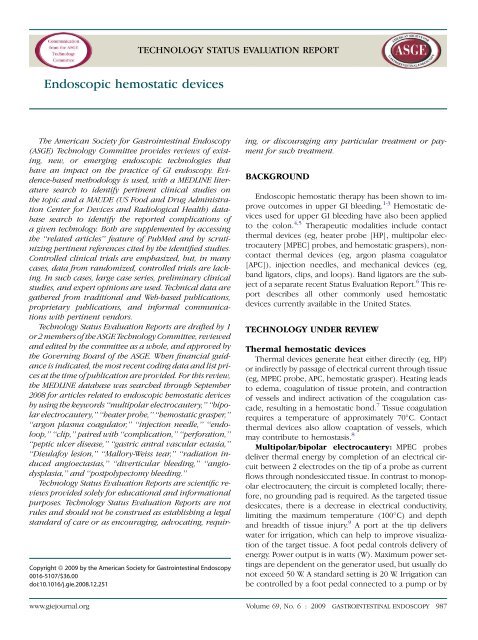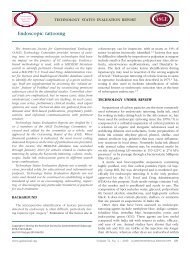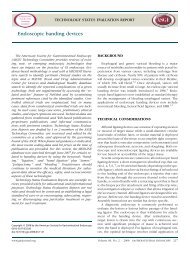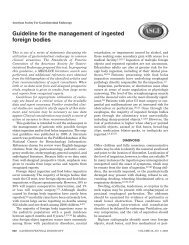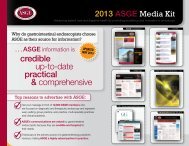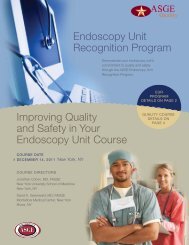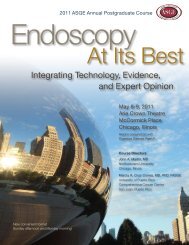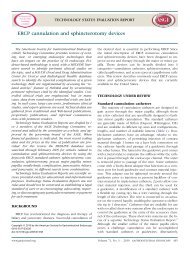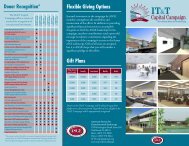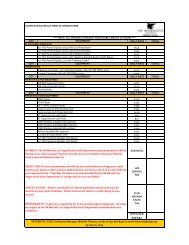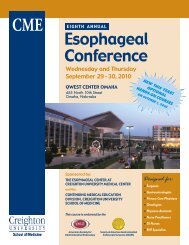Endoscopic hemostatic devices - American Society for ...
Endoscopic hemostatic devices - American Society for ...
Endoscopic hemostatic devices - American Society for ...
You also want an ePaper? Increase the reach of your titles
YUMPU automatically turns print PDFs into web optimized ePapers that Google loves.
TECHNOLOGY STATUS EVALUATION REPORT<br />
<strong>Endoscopic</strong> <strong>hemostatic</strong> <strong>devices</strong><br />
Copyright ª 2009 by the <strong>American</strong> <strong>Society</strong> <strong>for</strong> Gastrointestinal Endoscopy<br />
0016-5107/$36.00<br />
doi:10.1016/j.gie.2008.12.251<br />
The <strong>American</strong> <strong>Society</strong> <strong>for</strong> Gastrointestinal Endoscopy<br />
(ASGE) Technology Committee provides reviews of existing,<br />
new, or emerging endoscopic technologies that<br />
have an impact on the practice of GI endoscopy. Evidence-based<br />
methodology is used, with a MEDLINE literature<br />
search to identify pertinent clinical studies on<br />
the topic and a MAUDE (US Food and Drug Administration<br />
Center <strong>for</strong> Devices and Radiological Health) database<br />
search to identify the reported complications of<br />
a given technology. Both are supplemented by accessing<br />
the ‘‘related articles’’ feature of PubMed and by scrutinizing<br />
pertinent references cited by the identified studies.<br />
Controlled clinical trials are emphasized, but, in many<br />
cases, data from randomized, controlled trials are lacking.<br />
In such cases, large case series, preliminary clinical<br />
studies, and expert opinions are used. Technical data are<br />
gathered from traditional and Web-based publications,<br />
proprietary publications, and in<strong>for</strong>mal communications<br />
with pertinent vendors.<br />
Technology Status Evaluation Reports are drafted by 1<br />
or 2 members of the ASGE Technology Committee, reviewed<br />
and edited by the committee as a whole, and approved by<br />
the Governing Board of the ASGE. When financial guidance<br />
is indicated, the most recent coding data and list prices<br />
at the time of publication are provided. For this review,<br />
the MEDLINE database was searched through September<br />
2008 <strong>for</strong> articles related to endoscopic <strong>hemostatic</strong> <strong>devices</strong><br />
by using the keywords ‘‘multipolar electrocautery,’’ ‘‘bipolar<br />
electrocautery,’’ ‘‘heater probe,’’ ‘‘<strong>hemostatic</strong> grasper,’’<br />
‘‘argon plasma coagulator,’’ ‘‘injection needle,’’ ‘‘endoloop,’’<br />
‘‘clip,’’ paired with ‘‘complication,’’ ‘‘per<strong>for</strong>ation,’’<br />
‘‘peptic ulcer disease,’’ ‘‘gastric antral vascular ectasia,’’<br />
‘‘Dieulafoy lesion,’’ ‘‘Mallory-Weiss tear,’’ ‘‘radiation induced<br />
angioectasias,’’ ‘‘diverticular bleeding,’’ ‘‘angiodysplasia,’’<br />
and ‘‘postpolypectomy bleeding.’’<br />
Technology Status Evaluation Reports are scientific reviews<br />
provided solely <strong>for</strong> educational and in<strong>for</strong>mational<br />
purposes. Technology Status Evaluation Reports are not<br />
rules and should not be construed as establishing a legal<br />
standard of care or as encouraging, advocating, requiring,<br />
or discouraging any particular treatment or payment<br />
<strong>for</strong> such treatment.<br />
BACKGROUND<br />
<strong>Endoscopic</strong> <strong>hemostatic</strong> therapy has been shown to improve<br />
outcomes in upper GI bleeding. 1-3 Hemostatic <strong>devices</strong><br />
used <strong>for</strong> upper GI bleeding have also been applied<br />
to the colon. 4,5 Therapeutic modalities include contact<br />
thermal <strong>devices</strong> (eg, heater probe [HP], multipolar electrocautery<br />
[MPEC] probes, and <strong>hemostatic</strong> graspers), noncontact<br />
thermal <strong>devices</strong> (eg, argon plasma coagulator<br />
[APC]), injection needles, and mechanical <strong>devices</strong> (eg,<br />
band ligators, clips, and loops). Band ligators are the subject<br />
of a separate recent Status Evaluation Report. 6 This report<br />
describes all other commonly used <strong>hemostatic</strong><br />
<strong>devices</strong> currently available in the United States.<br />
TECHNOLOGY UNDER REVIEW<br />
Thermal <strong>hemostatic</strong> <strong>devices</strong><br />
Thermal <strong>devices</strong> generate heat either directly (eg, HP)<br />
or indirectly by passage of electrical current through tissue<br />
(eg, MPEC probe, APC, <strong>hemostatic</strong> grasper). Heating leads<br />
to edema, coagulation of tissue protein, and contraction<br />
of vessels and indirect activation of the coagulation cascade,<br />
resulting in a <strong>hemostatic</strong> bond. 7 Tissue coagulation<br />
requires a temperature of approximately 70 C. Contact<br />
thermal <strong>devices</strong> also allow coaptation of vessels, which<br />
may contribute to hemostasis. 8<br />
Multipolar/bipolar electrocautery: MPEC probes<br />
deliver thermal energy by completion of an electrical circuit<br />
between 2 electrodes on the tip of a probe as current<br />
flows through nondesiccated tissue. In contrast to monopolar<br />
electrocautery, the circuit is completed locally; there<strong>for</strong>e,<br />
no grounding pad is required. As the targeted tissue<br />
desiccates, there is a decrease in electrical conductivity,<br />
limiting the maximum temperature (100 C) and depth<br />
and breadth of tissue injury. 9 A port at the tip delivers<br />
water <strong>for</strong> irrigation, which can help to improve visualization<br />
of the target tissue. A foot pedal controls delivery of<br />
energy. Power output is in watts (W). Maximum power settings<br />
are dependent on the generator used, but usually do<br />
not exceed 50 W. A standard setting is 20 W. Irrigation can<br />
be controlled by a foot pedal connected to a pump or by<br />
www.giejournal.org Volume 69, No. 6 : 2009 GASTROINTESTINAL ENDOSCOPY 987
<strong>Endoscopic</strong> <strong>hemostatic</strong> <strong>devices</strong><br />
TABLE 1. Contact thermal <strong>devices</strong><br />
Manufacturer<br />
Device name<br />
Sheath<br />
diameter<br />
(French)<br />
Sheath<br />
length (cm)<br />
List price<br />
Special<br />
features<br />
Multipolar electrocautery probes<br />
Boston Scientific<br />
(Natick, Mass)<br />
Gold Probe 7, 10 300, 350 $285 each<br />
Injector Gold Probe 7, 10 210 $335 each Integrated 25-gauge<br />
injection needle<br />
ConMed <strong>Endoscopic</strong><br />
Technologies (Chelms<strong>for</strong>d,<br />
Mass)<br />
Bicap Superconductor,<br />
multielectrode bipolar probe<br />
Palladium tip bipolar<br />
hemostasis probe<br />
5, 7, 10 200, 300, 350 $310 each<br />
7, 10 300 $240 each<br />
Cook Medical (Winston-Salem,<br />
NC)<br />
Olympus America (Center<br />
Valley, Pa)<br />
Quicksilver bipolar probe 7, 10 350 $271 each<br />
SolarProbe 7, 10 350 $235 each<br />
US Endoscopy (Mentor, Ohio) Bipolar hemostasis probe 7, 10 350 $230 each<br />
Heater probes<br />
Olympus America HeatProbe 7, 10 230, 300 $530 each Reusable<br />
Hemostatic grasper<br />
Olympus America Coagrasper 7 165 $200 each Rotatable<br />
simply flushing the irrigation port with a syringe. Pressure<br />
is often applied to the target tissue during coagulation to<br />
ensure coaptation. Catheters come in several lengths and<br />
diameters that must be coordinated with the length and<br />
size of the working channel of the endoscope (Table 1).<br />
HP: The HP consists of a Teflon-coated hollow aluminum<br />
cylinder with an inner heating coil. A thermocoupling<br />
device at the tip of the probe maintains a constant temperature.<br />
In contrast to MPEC, the mechanism of tissue coagulation<br />
is direct heat transfer. Pressure is usually applied<br />
with HP therapy, and there is an irrigation port. A foot<br />
pedal controls heat activation and irrigation. HP activation<br />
delivers energy to the diode in the probe tip. Once the<br />
pulse has been initiated, the duration of activation is predetermined<br />
and cannot be stopped until the entire<br />
amount of preselected joules is delivered. 10<br />
Hemostatic grasper: The <strong>hemostatic</strong> grasper is a recently<br />
developed device similar to monopolar hot biopsy<br />
<strong>for</strong>ceps currently used <strong>for</strong> polypectomy. 11 The grasper operates<br />
much like a biopsy <strong>for</strong>ceps, although, unlike biopsy<br />
<strong>for</strong>ceps, the jaws are flat instead of cupped and the device<br />
is rotatable. The jaws are closed around the target tissue,<br />
and then monopolar electrocautery is used to desiccate<br />
the tissue. Clinical experience with this device is limited,<br />
with one study reporting the use of the <strong>hemostatic</strong><br />
grasper during a natural orifice transluminal endoscopic<br />
surgery cholecystectomy. 12<br />
APC: An APC is a noncontact electrocoagulation device<br />
that uses high-frequency monopolar alternating current<br />
conducted to target tissues through ionized argon gas (argon<br />
plasma). Electrons flow through a stream of electrically<br />
activated ionized argon gas from the probe<br />
electrode to the targeted tissue, causing tissue desiccation<br />
at the interface. As the tissue surface loses its electrical<br />
conductivity as a result of desiccation, the plasma stream<br />
shifts to adjacent nondesiccated (conductive) tissue,<br />
which limits the depth of injury. If the catheter is not<br />
near target tissue (ie, the resistance to electrical current<br />
flow is too great), there is no ignition of the gas, and depression<br />
of the foot pedal results only in flow of inert argon<br />
gas. Coagulation depth is dependent on the generator<br />
power setting, duration of application, and distance from<br />
the probe tip to the target tissue. 13 The optimal distance<br />
between the probe and tissue ranges from 2 to 8 mm. 14<br />
The available APC systems (ERBE USA, Marietta, Ga;<br />
ConMed Electrosurgery, Centennial, Colo; Canady Technology,<br />
Pittsburgh, Pa) include a specialized electrosurgical<br />
generator capable of high-frequency monopolar<br />
current, an activation foot pedal, an argon gas cylinder,<br />
disposable grounding pads, and flexible, single-use delivery<br />
probes. A gas flow meter adjusts to allow argon flow<br />
rates of 0.5 to 7 L/min. These generators can also serve<br />
as multipurpose electrosurgical units capable of varying<br />
levels of power output with any monopolar or bipolar<br />
988 GASTROINTESTINAL ENDOSCOPY Volume 69, No. 6 : 2009 www.giejournal.org
<strong>Endoscopic</strong> <strong>hemostatic</strong> <strong>devices</strong><br />
TABLE 2. Noncontact thermal <strong>devices</strong><br />
Manufacturer<br />
Device name<br />
Sheath<br />
diameter<br />
(French)<br />
Sheath<br />
length (cm) Fire direction List price Special features<br />
Canady (Hampton, Va)<br />
Canady plasma<br />
GI probe<br />
5, 7 230, 340 Straight, side $1550/box of 10<br />
ConMed <strong>Endoscopic</strong><br />
Technologies<br />
(Chelms<strong>for</strong>d, Mass)<br />
Beamer argon probe 5, 7, 10 160, 230, 320 Straight fire $2550/box of 10<br />
Beamer argon snare<br />
probe<br />
7 160, 230 Straight fire $1750/box of 5 Combination APC<br />
probe and snare<br />
ERBE (Marietta, Ga) APC probe 5, 7, 10 150, 220, 300 Straight, side,<br />
circumferential<br />
FiAPC probe 5, 7, 10 150, 220, 300 Straight, side,<br />
circumferential<br />
$1995-2305/box of 10*<br />
$2077-2387/box of 10y<br />
Integrated filter<br />
APC, Argon plasma coagulation.<br />
*All probes $1995/box of 10 except the side-fire probes ($2050/box of 10) and the 300-cm probes ($2305/box of 10).<br />
yAll probes $2077/box of 10 except circumferential and side-fire probes ($2132/box of 10) and 300-cm probes ($2387/box of 10).<br />
endoscopic accessory. Probes are composed of Teflon<br />
(DuPont, Wilmington, Del) with a ceramic tip encasing<br />
the tungsten electrode. They are available in a variety of<br />
lengths and widths (Table 2). Probes are available with <strong>for</strong>ward,<br />
side, or circumferential ports allowing <strong>for</strong>ward, tangential,<br />
or circumferential applications, respectively.<br />
Injection needles<br />
Injection needles consist of an outer sheath (plastic, Teflon,<br />
or stainless steel) and an inner hollow-core needle<br />
(19-25 gauge) (Table 3). Using a handle on the end of the<br />
needle sheath, the operator can retract the needle into<br />
the sheath <strong>for</strong> safe passage through the working channel<br />
of the endoscope. When the catheter is placed near the target<br />
tissue, the needle can be extended out of the end of the<br />
sheath to a preset distance, and a syringe attached to the<br />
handle is used to inject liquid agents into the target tissue.<br />
Injection of various solutions achieves hemostasis by both<br />
mechanical tamponade and cytochemical mechanisms. 15<br />
Mechanical <strong>hemostatic</strong> <strong>devices</strong><br />
<strong>Endoscopic</strong> clipping <strong>devices</strong>: All endoscopic clipping<br />
<strong>devices</strong> have 3 main components: a metal doubleor<br />
triple-pronged preloaded clip, a delivery catheter, and<br />
a handle used to operate and deploy the clip. Clips are<br />
available in a variety of jaw lengths (Table 4). The delivery<br />
catheter consists of a metal cable within a metal coil<br />
sheath enclosed within a Teflon catheter. The tip of the<br />
metal cable has a hook onto which the clip is attached.<br />
The handle consists of 2 sliding components. The first allows<br />
advancement of the metal cable holding the clip out<br />
of the protective sheath. The second is the plunger that<br />
controls opening, closing, and deployment of the clip. After<br />
insertion of the catheter through the working channel<br />
of the endoscope, the clip is extended out of the sheath.<br />
The clip is then positioned over the target and opened<br />
with the plunger handle. A rotation mechanism on the<br />
handle of some clips allows a change in orientation of<br />
the clip jaws. The jaws of the clip are applied with pressure<br />
and closed onto the target tissue by using the device<br />
handle. 16 Some clips may be reopened and repositioned,<br />
whereas others are permanently deployed and released<br />
on closure. Similarly, some clips are automatically released<br />
on deployment, and others require repositioning of the<br />
plunger handle to release the deployed clip from the catheter.<br />
Hemostasis is achieved by mechanical compression.<br />
Detachable loop ligating <strong>devices</strong>: Detachable loop<br />
ligating <strong>devices</strong> consist of a circular- or elliptical-shaped<br />
nylon loop preloaded onto a delivery system that includes<br />
a hook wire (to which the loop is attached) within a Teflon<br />
sheath and an operating handle. Some older <strong>devices</strong> required<br />
preloading of the loop onto the hook wire. The<br />
loop is advanced out of the sheath and placed around<br />
the target tissue, usually the stalk of a large pedunculated<br />
polyp. The loop is tightened with advancement of a silicon<br />
rubber stopper by using the handle. When the loop is<br />
closed to the desired extent, as evidenced by tissue cyanosis<br />
or hemostasis, it is then released from the hook wire.<br />
There is a separate loop-cutting device that can be used<br />
to cut and release the nylon loop if it is malpositioned<br />
or fails to release from the catheter.<br />
EASE OF USE<br />
Thermal <strong>hemostatic</strong> <strong>devices</strong> are relatively easy to use<br />
because they require only direct or indirect (eg, APC) contact<br />
with the target tissue. Use of argon plasma coagulation<br />
requires an endoscopist to have fine control of the<br />
www.giejournal.org Volume 69, No. 6 : 2009 GASTROINTESTINAL ENDOSCOPY 989
<strong>Endoscopic</strong> <strong>hemostatic</strong> <strong>devices</strong><br />
TABLE 3. Injection needles<br />
Manufacturer<br />
Device name<br />
Sheath<br />
diameter<br />
(French)<br />
Sheath<br />
length (cm)<br />
Needle<br />
gauge<br />
Needle<br />
length (mm)<br />
List price<br />
Special<br />
features<br />
Boston Scientific<br />
(Natick, Mass))<br />
Interject sclerotherapy<br />
needle<br />
7 200, 240 23, 25 4, 6 $37 each<br />
ConMed <strong>Endoscopic</strong><br />
Technologies<br />
(Chelms<strong>for</strong>d, Mass)<br />
Click-Tip injection needle 7 180, 230 19, 22, 25 4, 6 $580/box of 10<br />
FlexiTip disposable<br />
sclerotherapy needle<br />
7 160, 230 25 4, 5, 6 $255/box of 5<br />
Sure Shot injection needle 7 230 25 5 $315/box of 5<br />
Cook Medical<br />
(Winston-Salem,<br />
NC)<br />
AcuJet variable<br />
injection needle<br />
7 220 23, 25 Variable $42 each<br />
Disposable varices injector 7 200-320 23, 25 Variable $48 each<br />
Injectaflow variable<br />
injection needle<br />
7 220 23, 25 Variable $61 each Flush port<br />
Kimberly-Clark<br />
(Roswell, Ga)<br />
Injection needle catheter 7 160, 200, 240 23, 25 4, 6 $260/box of 10<br />
Olympus America<br />
(Center Valley, Pa)<br />
TeleMed Systems<br />
(Hudson, Mass)<br />
US Endoscopy<br />
(Mentor, Ohio)<br />
Injector Force injection<br />
needle<br />
Sure-Stop sclerotherapy<br />
needle<br />
Articulator injection<br />
needle<br />
Carr-Locke injection<br />
needle<br />
7 165-230 21, 23, 25 4, 5, 6, 8 $276/box of 6<br />
5, 7 160-240 21, 23, 25 4, 5 $130/box of 5<br />
7 160, 230, 350 25 4, 5 $250/box of 5<br />
7 230 25 5 $275/box of 5<br />
iSnare 10 230 23, 25 5 $625/box of 5 2.5 4-cm<br />
integrated<br />
snare<br />
Vari-Safe injection needle 7 230 23 4, 5, 7 $50 each<br />
endoscope because the optimal distance of 2 to 8 mm<br />
from the device to the tissue target must be maintained<br />
during energy delivery. Power generators <strong>for</strong> contact thermal<br />
probes and APCs are portable and use a standard 110-<br />
V outlet. Ten-French probes require an endoscope with<br />
a working channel larger than 3.4 mm. Repeated application<br />
of thermal energy can result in the buildup of coagulum<br />
at the catheter tip, which can impede conductivity,<br />
necessitating removal of the probe and cleaning of the tip.<br />
For mechanical methods of hemostasis, injection needles<br />
require only an understanding of how the handle<br />
works to extend the needle from the sheath. Both clips<br />
and detachable loops have more complex delivery mechanisms<br />
and handles that require a high degree of coordination<br />
between the endoscopist and endoscopy<br />
assistant. Use of an angulated endoscope or a side-viewing<br />
endoscope may make deployment of clips and advancement<br />
of injection needles difficult. If the position of<br />
some targeted lesions limits visualization or results in tangential<br />
orientation, clips may be difficult to place. Additionally,<br />
if there is a vessel within an ulcer with a large<br />
fibrotic base, there may not be adequate tissue to anchor<br />
a clip device. Optimal positioning of a clip and loop device<br />
be<strong>for</strong>e deployment generally requires more experience<br />
relative to standard diagnostic endoscopic methods.<br />
EFFICACY AND COMPARATIVE ANALYSIS<br />
Peptic ulcer disease<br />
Several meta-analyses including more than 1000 patients<br />
have shown that thermal <strong>hemostatic</strong> <strong>devices</strong>, injection<br />
therapy, and clips either in combination or alone are<br />
all highly successful in achieving initial hemostasis in<br />
990 GASTROINTESTINAL ENDOSCOPY Volume 69, No. 6 : 2009 www.giejournal.org
<strong>Endoscopic</strong> <strong>hemostatic</strong> <strong>devices</strong><br />
TABLE 4. Mechanical <strong>hemostatic</strong> <strong>devices</strong><br />
Manufacturer<br />
Device<br />
name<br />
Sheath diameter<br />
(French)<br />
Sheath<br />
length (cm)<br />
Jaw opening<br />
width (mm)<br />
List price<br />
Special<br />
features<br />
<strong>Endoscopic</strong> clipping<br />
<strong>devices</strong><br />
Boston Scientific<br />
(Natick, Mass)<br />
Cook Medical<br />
(Bloomington, Ind)<br />
Resolution clip 7 155, 235 11 $145 each 2-prong clip<br />
Triclip 7, 8 207 12 $316 (box of 3) 3-prong clip,<br />
8-French model<br />
has flush port<br />
Olympus America<br />
(Center Valley, Pa)<br />
Detachable loop-ligating<br />
<strong>devices</strong><br />
QuickClip2 7 165, 230 9 $95 each (box of<br />
5 or 20)<br />
QuickClip2 long 7 165, 230 11 $95 each (box of<br />
5 or 20)<br />
2-prong clip, rotatable<br />
2-prong clip, rotatable<br />
Olympus America Endo-Loop 7 195, 230 30* $330/box of 10<br />
loops, $570 each<br />
<strong>for</strong> catheter<br />
*Loop diameter.<br />
Nonsterile, reusable<br />
catheter<br />
Poly-Loop 7 230 30* $525/box of 5 Sterile, single-use<br />
loop and catheter<br />
bleeding peptic ulcer disease. Clips and thermal therapy,<br />
either alone or paired with injection therapy, are superior<br />
to injection therapy alone in preventing rebleeding and<br />
the need <strong>for</strong> surgery. There is no significant difference between<br />
clips and thermal therapy in rebleeding rates, the<br />
need <strong>for</strong> surgery, and mortality. 1-3,17<br />
Numerous prospective, randomized studies have compared<br />
thermal therapies with no treatment, thermal therapies<br />
with injection, thermal therapies with each other,<br />
and thermal therapies combined with injection. In several<br />
studies, the use of an MPEC probe and an HP<br />
have been compared with no treatment or sham procedures<br />
and show immediate hemostasis rates of 78% to<br />
100%, significantly lower rebleeding rates (0%-18% vs<br />
20%-41%), and a decreased need <strong>for</strong> surgery, shorter<br />
length of hospitalization, and less need <strong>for</strong> transfusion.<br />
10,18-21 Comparisons among different thermal modalities<br />
show that they are all similar in rebleeding rates,<br />
need <strong>for</strong> surgery, and transfusion requirements. 14,22,23<br />
Early studies demonstrated that the use of an APC,<br />
MPEC probe, and HP have similar efficacy in initial hemostasis<br />
and decreasing rebleeding rates compared with injection<br />
therapy of epinephrine alone, sclerosant alone, or<br />
combined sclerosant and epinephrine. 24-28 Injection therapy<br />
with saline solution alone is significantly less effective<br />
than MPEC in treating bleeding ulcers, with rebleeding<br />
rates of 29% versus 12% with MPEC. 29 MPEC paired<br />
with epinephrine injection prevents rebleeding and<br />
decreases transfusion requirements compared with<br />
epinephrine injection alone, with rebleeding rates of<br />
6.7% versus 30%, respectively. 30 The use of an HP or<br />
APC paired with epinephrine injection is equally efficacious<br />
in treating high-risk peptic ulcers. 31 Epinephrine injection<br />
followed by MPEC also has a higher rate of initial<br />
hemostasis than epinephrine injection alone. 32<br />
Clips have been compared with thermal therapy, injection<br />
therapy alone, and thermal therapy combined with<br />
injection in many randomized trials. Clips and APCs have<br />
similar efficacy in initial hemostasis, recurrent bleeding,<br />
30-day mortality, and the need <strong>for</strong> emergency surgery. 14<br />
One study showed that the rate of recurrent bleeding is<br />
higher with an HP than clips (21% vs 1.8%, P ! .05). 33<br />
Another study demonstrated that initial hemostasis was<br />
higher with an HP compared with clips (100% vs 85%,<br />
P Z .01), although no significant difference was seen in<br />
rebleeding, transfusion requirements, or 30-day mortality.<br />
34 Clips have been compared with an HP paired with<br />
epinephrine injection with similar clinical outcomes. 35<br />
One study showed a higher rebleeding rate in a group<br />
with epinephrine injection followed by the use of an HP<br />
(33%) relative to clips alone (5%). 36 Clips have also been<br />
compared with injection therapy as well as the combination<br />
therapy of clips and injection therapy. Clinical outcomes<br />
were similar between the groups. 31,37-39 One<br />
study found that the rebleeding rate was higher in the epinephrine<br />
injection alone group than in the combination<br />
therapy group with clips paired with epinephrine injection<br />
(21% vs 3.8%, P Z .008). 40<br />
www.giejournal.org Volume 69, No. 6 : 2009 GASTROINTESTINAL ENDOSCOPY 991
<strong>Endoscopic</strong> <strong>hemostatic</strong> <strong>devices</strong><br />
Gastric antral vascular ectasia<br />
APC is the most commonly reported modality <strong>for</strong> the<br />
ablation of gastric antral vascular ectasia (GAVE). Multiple<br />
sessions are usually required, but transfusion requirements<br />
can be eliminated in more than 70% of patients.<br />
41-43 MPEC and HP have also been described <strong>for</strong><br />
the ablation of GAVE. 44,45 Long-term sequelae of ablation<br />
include antral scarring and hyperplastic polyps. 46 A recent<br />
retrospective study of thermal therapy (APC or MPEC<br />
probe) compared with band ligation found that band ligation<br />
required fewer sessions <strong>for</strong> cessation of bleeding. 47<br />
Newer mucosal ablation techniques 48 such as radiofrequency<br />
ablation and cryotherapy have also been used to<br />
ablate GAVE in small pilot studies. A study of 26 patients<br />
with a variety of bleeding lesions (eg, GAVE, arteriovenous<br />
mal<strong>for</strong>mations, radiation proctitis, radiation gastritis) were<br />
treated with cryotherapy with a mean of 3.6 sessions. 49<br />
These patients had previously undergone treatment with<br />
MPEC and HP but continued to have bleeding. Cryotherapy<br />
with nitrous oxide was efficacious in causing hemostasis<br />
in 77% overall, with follow-up of 6 months. In another<br />
recent report of 12 patients, including 8 patients in whom<br />
the use of an APC failed, cryotherapy resulted in a decrease<br />
in transfusion requirement and an increase in hemoglobin.<br />
50 A pilot study of 6 patients with GAVE treated with<br />
the HALO90 device (Barrx Medical, Sunnyvale, Calif)<br />
showed improved hemoglobin concentrations in all<br />
patients after 1 to 3 treatments. Five of 6 patients were<br />
no longer transfusion dependent. 51<br />
Angiodysplasia<br />
MPEC probes, HPs, and APCs have all been described in<br />
treating angiodysplasia encountered in the GI tract during<br />
upper endoscopy, enteroscopy, and colonoscopy. 52-54 One<br />
series of 16 patients showed that thermal ablation of angiodysplasia<br />
decreased transfusion requirements in 76%<br />
of patients and that only 1 to 2 sessions were needed<br />
<strong>for</strong> ablation compared with a mean of 6 sessions needed<br />
to ablate GAVE. 43 In contrast to treating bleeding peptic<br />
ulcers, lower power settings and lower appositional <strong>for</strong>ces<br />
are used with MPEC and HP treatment of angiodysplasia.<br />
Dieulafoy lesions<br />
Injections of epinephrine, ethanol, or histoacryl have<br />
been described as successful in stopping bleeding from<br />
Dieulafoy lesions. Epinephrine injection followed by thermal<br />
therapy (eg, MPEC, HP) or clip placement has also<br />
been effective in small case series. 55-58 A prospective, randomized<br />
trial of 24 patients compared mechanical <strong>devices</strong><br />
(clips or band ligation) and injection of hypertonic saline<br />
solution <strong>for</strong> Dieulafoy lesions. 59 The rate of rebleeding<br />
was significantly lower in the mechanical group (8%)<br />
than in the injection group (33%).<br />
Mallory-Weiss tears<br />
Studies of endoscopic therapy <strong>for</strong> Mallory-Weiss tears<br />
have focused on actively bleeding lesions. A randomized,<br />
controlled trial of 44 patients undergoing MPEC versus<br />
sham MPEC in active upper GI bleeding revealed that in<br />
a subgroup of 17 patients with Mallory-Weiss tears, there<br />
was a significant improvement in the MPEC group with regard<br />
to initial hemostasis (100% vs 13%) and emergency<br />
surgery or other intervention and a trend toward less<br />
need <strong>for</strong> transfusions. 19 A prospective, randomized study<br />
of 41 patients with actively bleeding Mallory-Weiss tears<br />
randomized to clips or band ligation showed that all patients<br />
had immediate hemostasis, and only 1 patient<br />
rebled in the clip group and 2 in the banding group. 60 A<br />
study of 35 patients with actively bleeding or oozing Mallory-Weiss<br />
tears were prospectively randomized to either<br />
clip application or epinephrine injection. 61 There was no<br />
difference in immediate hemostasis or rebleeding.<br />
Radiation-induced angioectasias<br />
The use of MPEC, HP, and APC has been described in<br />
small case series as successful treatments <strong>for</strong> bleeding<br />
from radiation-induced angioectasias, usually in the rectum.<br />
Multiple sessions were typically required <strong>for</strong> complete<br />
ablation. 62-65 Other mucosal ablation therapies<br />
such as cryotherapy and radiofrequency ablation have<br />
also been used <strong>for</strong> radiation-induced angioectasias. 49,51<br />
Diverticular bleeding<br />
Epinephrine injection with or without MPEC has been<br />
described in observational studies as an effective measure<br />
to obtain initial hemostasis in diverticular bleeding. 4,5<br />
Case reports also describe the use of clips in diverticular<br />
bleeding. 66-68<br />
Postpolypectomy bleeding<br />
Various combinations of epinephrine injection, MPEC,<br />
and HP application to postpolypectomy bleeding sites<br />
have been described. 69 Clips have also been used to<br />
stop postpolypectomy bleeding. 66,70 Detachable loops<br />
were developed <strong>for</strong> the prevention of postpolypectomy<br />
bleeding. Small case series have described the feasibility<br />
of placing loops be<strong>for</strong>e polypectomy. 71,72 Several prospective,<br />
randomized studies evaluated the role of detachable<br />
loops, clips, and injection therapy in the prevention of<br />
postpolypectomy bleeding after removal of large polyps.<br />
A study of 159 patients showed that the application of a detachable<br />
loop with epinephrine injection resulted in a significant<br />
decrease in immediate bleeding compared with<br />
epinephrine injection alone (1% vs 9%), although there<br />
was no difference in delayed bleeding. 73 A study comparing<br />
loop placement, epinephrine injection, and no therapy<br />
showed that there is a significant increase in postpolypectomy<br />
bleeding with the removal of large polyps (O2 cm)<br />
when no therapy is used (2.7% vs 2.9% vs 15.1%,<br />
992 GASTROINTESTINAL ENDOSCOPY Volume 69, No. 6 : 2009 www.giejournal.org
<strong>Endoscopic</strong> <strong>hemostatic</strong> <strong>devices</strong><br />
TABLE 5. CPT codes <strong>for</strong> endoscopic hemostasis<br />
CPT code description Esophagoscopy EGD Enteroscopy Stoma Flex sig Colonoscopy<br />
Control of bleeding, any method* 43227 43255 44366 44391 45334 45382<br />
Injection sclerosis 43204 43243<br />
Removal by ablation technique 43228 43258 44369 44393 45339 45383<br />
CPT (Current Procedural Terminology) is a registered trademark of the <strong>American</strong> Medical Association. CPT codes ª 2008 <strong>American</strong> Medical Association.<br />
All rights reserved.<br />
Flex sig, Flexible sigmoidoscopy.<br />
*Any method may include, but is not limited to, the following hemostasis techniques: injection, bipolar cautery, unipolar cautery, laser, heater probe, clip, or<br />
argon plasma coagulator.<br />
respectively). 74 One study in patients undergoing saline<br />
solution lift polypectomy showed that the addition of epinephrine<br />
had no effect on the rate of postpolypectomy<br />
bleeding. 75 Another study demonstrated no decrease in<br />
postpolypectomy bleeding with prophylactic clip placement.<br />
76 The data to date, there<strong>for</strong>e, reveal no clear benefit<br />
of routine prophylactic therapy with the possible exception<br />
of the use of detachable loops and epinephrine injection<br />
in large pedunculated polyps.<br />
SAFETY<br />
Thermal <strong>hemostatic</strong> <strong>devices</strong><br />
Rare per<strong>for</strong>ations of peptic ulcers treated with MPEC<br />
and precipitation of bleeding (the majority stopped with<br />
further application of MPEC) in as many as 18% of patients<br />
have been reported. 20 Colonic per<strong>for</strong>ation after treatment<br />
of angiodysplasia, particularly in the right colon, has been<br />
reported in as many as 2.5% of cases. 77<br />
The rate of per<strong>for</strong>ation after treatment of GI bleeding<br />
with HP has been reported to be as high as 1.8% to 3%,<br />
and precipitation of bleeding has been reported in as<br />
many as 5% of patients. 1,78,79 Colonic per<strong>for</strong>ation with application<br />
of an HP to angiodysplasia in the cecum has also<br />
been reported. 80<br />
Complications from an APC are rare and include distention<br />
of the GI tract with argon gas, submucosal emphysema,<br />
pneumomediastinum, and pneumoperitoneum. 14,81,82 Per<strong>for</strong>ation<br />
has been described after the use of an APC in the<br />
duodenum and colon. 80 These complications may be related<br />
to the power setting, duration of application, and distance<br />
of the probe tip to the target tissue. 13 Cases of<br />
intracolonic gas explosion caused by ignition of accumulated<br />
oxygen, hydrogen, and methane have also been described.<br />
These explosions occurred in patients with<br />
incomplete or inadequate colonic cleansing or when malabsorbed<br />
carbohydrates were used as a bowel preparation.<br />
83,84 There<strong>for</strong>e, complete colonic cleansing with<br />
a polyethylene glycol- or saline solution-based laxative<br />
should be used be<strong>for</strong>e using APC in the colon.<br />
Injection needles<br />
Complications of injection therapy are usually related<br />
to the substance injected rather than the needle itself.<br />
However, there are reports of needles failing to extend<br />
from their sheaths and of needles separating from the<br />
catheter in the patient and requiring retrieval. No direct<br />
patient harm has been reported from either of these device<br />
failures. 80 Cardiac arrhythmias and hypertension<br />
have been reported after epinephrine injection. 85 Most<br />
complications occurring from injection therapy are complications<br />
related to esophageal variceal sclerotherapy. 86<br />
Sclerotherapy complications may occur in as many as<br />
50% of patients and can be separated into local complications<br />
including retrosternal pain, dysphagia, odynophagia,<br />
ulcerations, strictures, bleeding, per<strong>for</strong>ation, and systemic<br />
complications including fever, bacteremia, sepsis, pleural<br />
effusions, pneumonia, and adult respiratory distress syndrome.<br />
87-89<br />
Mechanical <strong>hemostatic</strong> <strong>devices</strong><br />
There are numerous reports of handle malfunction, the<br />
inability to separate the clip from the catheter after deployment,<br />
and premature deployment of the clip. There<br />
is one report of inadvertent colon per<strong>for</strong>ation while attempting<br />
to deploy a clip <strong>for</strong> a postpolypectomy bleed. Interestingly,<br />
this small per<strong>for</strong>ation was closed with another<br />
clip. One reported incident of a clip failing to detach from<br />
the catheter led to additional bleeding that was successfully<br />
treated with another clip. 80 Clips are complex mechanical<br />
<strong>devices</strong>, and whether these reports represent<br />
device failure or operator inexperience with the device<br />
is not discernible. Although most clips detach and pass<br />
without incident within days, there have been reports of<br />
clips retained at the site of deployment <strong>for</strong> prolonged periods.<br />
16,90 The clinical significance of clip retention is unknown,<br />
but there have been no adverse consequences<br />
reported. None of the clips described in this review are<br />
magnetic resonance imaging safe.<br />
Detachable loop ligating <strong>devices</strong> have been associated<br />
with loop entanglement with snare complicating polypectomy,<br />
slippage of the loop resulting in delayed bleeding,<br />
www.giejournal.org Volume 69, No. 6 : 2009 GASTROINTESTINAL ENDOSCOPY 993
<strong>Endoscopic</strong> <strong>hemostatic</strong> <strong>devices</strong><br />
and inadvertent transection of the polyp stalk leading to<br />
immediate bleeding. 91<br />
FINANCIAL CONSIDERATIONS<br />
Commonly used CPT* (Current Procedural Terminology)<br />
codes <strong>for</strong> endoscopic hemostasis are shown in the<br />
Table 5, and the detailed instructions <strong>for</strong> use of these numerous<br />
individual codes are provided elsewhere. 92 Tables<br />
1 through 4 contain the list price of frequently used <strong>hemostatic</strong><br />
<strong>devices</strong> available in the United States. The costs vary<br />
greatly among the different <strong>devices</strong>. Thermal probes are<br />
the most expensive <strong>devices</strong>, costing typically several hundred<br />
dollars each. The HP is more expensive but is reusable,<br />
whereas MPEC probes and APC catheters are single<br />
use. Clips and loops are approximately $100 each, although<br />
a mean use of 3 clips per patient <strong>for</strong> peptic ulcer<br />
bleeding has been reported. 66 Injection needles are the<br />
least expensive <strong>devices</strong>, costing approximately $50 each,<br />
although they are commonly used in conjunction with<br />
thermal probes or clips. All prices were obtained from<br />
the vendors as of September 1, 2008. Two cost identification<br />
studies have shown that in patients with bleeding<br />
peptic ulcers, the mean cost of hospitalization in patients<br />
treated with endoscopic therapy is less than half of the<br />
cost <strong>for</strong> patients treated with medical-surgical therapy. 19,93<br />
AREAS FOR FUTURE RESEARCH<br />
The optimal device <strong>for</strong> ablation of GAVE and angiodysplasia<br />
remains unclear. New technologies using radiofrequency<br />
ablation and cryotherapy may also hold promise<br />
in ablating GAVE, 49-51 but require further study. The role<br />
of endoscopic therapy in diverticular bleeding remains unclear,<br />
as does the optimal modality <strong>for</strong> hemostasis. The patient<br />
group most likely to benefit from the use of<br />
mechanical <strong>hemostatic</strong> <strong>devices</strong> such as clips and loops<br />
in the prevention of immediate or delayed postpolypectomy<br />
bleeding requires further study.<br />
SUMMARY<br />
<strong>Endoscopic</strong> therapy improves clinical outcomes <strong>for</strong><br />
many causes of GI bleeding. There are many safe and effective<br />
<strong>devices</strong> available <strong>for</strong> endoscopic <strong>hemostatic</strong> therapy.<br />
Although there are few compelling data favoring<br />
a particular device <strong>for</strong> treatment of various etiologies of<br />
GI bleeding, patients with peptic ulcer disease requiring<br />
intervention will benefit from the combination of thermal<br />
*CPT (Current Procedural Terminology) is a registered trademark of the<br />
<strong>American</strong> Medical Association. CPT codes ª 2008 <strong>American</strong> Medical<br />
Association. All rights reserved.<br />
therapy or clips and injection therapy compared with injection<br />
therapy alone. Selection of the optimal <strong>hemostatic</strong><br />
device depends on characteristics of the lesion, local expertise,<br />
equipment availability, and cost.<br />
Abbreviations: APC, argon plasma coagulator; ASGE, <strong>American</strong> <strong>Society</strong><br />
<strong>for</strong> Gastrointestinal Endoscopy; GAVE, gastric antral vascular ecstasia;<br />
HP, heater probe; MPEC, multipolar electrocautery.<br />
REFERENCES<br />
1. Cook DJ, Guyatt GH, Salena BJ, et al. <strong>Endoscopic</strong> therapy <strong>for</strong> acute<br />
nonvariceal upper gastrointestinal hemorrhage: a meta-analysis.<br />
Gastroenterology 1992;102:139-48.<br />
2. Sacks HS, Chalmers TC, Blum AL, et al. <strong>Endoscopic</strong> hemostasis. An<br />
effective therapy <strong>for</strong> bleeding peptic ulcers. JAMA 1990;264:494-9.<br />
3. Sung JJ, Tsoi KK, Lai LH, et al. <strong>Endoscopic</strong> clipping versus injection and<br />
thermo-coagulation in the treatment of non-variceal upper gastrointestinal<br />
bleeding: a meta-analysis. Gut 2007;56:1364-73.<br />
4. Bloomfeld RS, Rockey DC, Shetzline MA. <strong>Endoscopic</strong> therapy of acute<br />
diverticular hemorrhage. Am J Gastroenterol 2001;96:2367-72.<br />
5. Jensen DM, Machicado GA, Jutabha R, et al. Urgent colonoscopy <strong>for</strong><br />
the diagnosis and treatment of severe diverticular hemorrhage.<br />
N Engl J Med 2000;342:78-82.<br />
6. Liu J, Petersen BT, Tierney WM, et al. <strong>Endoscopic</strong> banding <strong>devices</strong>.<br />
Gastrointest Endosc 2008;68:217-21.<br />
7. Wara P, Berg V, Jacobsen NO, et al. Possible mechanism of hemostasis<br />
effected by electrocoagulation. Endoscopy 1984;16:43-6.<br />
8. Harrison JD, Morris DL. Does bipolar electrocoagulation time affect<br />
vessel weld strength Gut 1991;32:188-90.<br />
9. Laine L. Therapeutic endoscopy and bleeding ulcers. Bipolar/multipolar<br />
electrocoagulation. Gastrointest Endosc 1990;36(Suppl):S38-41.<br />
10. Fullarton GM, Birnie GG, Macdonald A, et al. Controlled trial of heater<br />
probe treatment in bleeding peptic ulcers. Br J Surg 1989;76:541-4.<br />
11. Barkun A, Liu J, Carpenter S, et al. Update on endoscopic tissue<br />
sampling <strong>devices</strong>. Gastrointest Endosc 2006;63:741-5.<br />
12. Meining A, Wilhelm D, Burian M, et al. Development, standardization,<br />
and evaluation of NOTES cholecystectomy using a transsigmoid<br />
approach in the porcine model: an acute feasibility study. Endoscopy<br />
2007;39:860-4.<br />
13. Watson JP, Bennett MK, Griffin SM, et al. The tissue effect of argon<br />
plasma coagulation on esophageal and gastric mucosa. Gastrointest<br />
Endosc 2000;52:342-5.<br />
14. Cipolletta L, Bianco MA, Rotondano G, et al. Prospective comparison of<br />
argon plasma coagulator and heater probe in the endoscopic treatment<br />
of major peptic ulcer bleeding. Gastrointest Endosc 1998;48:<br />
191-5.<br />
15. Nelson DB, Bosco JJ, Curtis WD, et al. ASGE technology status evaluation<br />
report. Injection needles. February 1999. Gastrointest Endosc<br />
1999;50:928-31.<br />
16. Chuttani R, Barkun A, Carpenter S, et al. <strong>Endoscopic</strong> clip application<br />
<strong>devices</strong>. Gastrointest Endosc 2006;63:746-50.<br />
17. Laine L, McQuaid KR. <strong>Endoscopic</strong> therapy <strong>for</strong> bleeding ulcers: an<br />
evidence-based approach based on meta-analyses of randomized<br />
controlled trials. Clin Gastroenterol Hepatol 2009;7:33-47.<br />
18. Jaramillo JL, Carmona C, Galvez C, et al. Efficacy of the heater probe in<br />
peptic ulcer with a non-bleeding visible vessel. A controlled, randomised<br />
study. Gut 1993;34:1502-6.<br />
19. Laine L. Multipolar electrocoagulation in the treatment of active upper<br />
gastrointestinal tract hemorrhage. A prospective controlled trial.<br />
N Engl J Med 1987;316:1613-7.<br />
20. Laine L. Multipolar electrocoagulation in the treatment of peptic<br />
ulcers with nonbleeding visible vessels. A prospective, controlled trial.<br />
Ann Intern Med 1989;110:510-4.<br />
994 GASTROINTESTINAL ENDOSCOPY Volume 69, No. 6 : 2009 www.giejournal.org
<strong>Endoscopic</strong> <strong>hemostatic</strong> <strong>devices</strong><br />
21. Tekant Y, Goh P, Alexander DJ, et al. Combination therapy using<br />
adrenaline and heater probe to reduce rebleeding in patients with<br />
peptic ulcer haemorrhage: a prospective randomized trial. Br J Surg<br />
1995;82:223-6.<br />
22. Hui WM, Ng MM, Lok AS, et al. A randomized comparative study of<br />
laser photocoagulation, heater probe, and bipolar electrocoagulation<br />
in the treatment of actively bleeding ulcers. Gastrointest Endosc 1991;<br />
37:299-304.<br />
23. Lin HJ, Wang K, Perng CL, et al. Heater probe thermocoagulation and multipolar<br />
electrocoagulation <strong>for</strong> arrest of peptic ulcer bleeding. A prospective,<br />
randomized comparative trial. J Clin Gastroenterol 1995;21:99-102.<br />
24. Choudari CP, Rajgopal C, Palmer KR. Comparison of endoscopic injection<br />
therapy versus the heater probe in major peptic ulcer haemorrhage.<br />
Gut 1992;33:1159-61.<br />
25. Laine L. Multipolar electrocoagulation versus injection therapy in the<br />
treatment of bleeding peptic ulcers. A prospective, randomized trial.<br />
Gastroenterology 1990;99:1303-6.<br />
26. Llach J, Bordas JM, Salmeron JM, et al. A prospective randomized trial<br />
of heater probe thermocoagulation versus injection therapy in peptic<br />
ulcer hemorrhage. Gastrointest Endosc 1996;43:117-20.<br />
27. Skok P, Krizman I, Skok M. Argon plasma coagulation versus injection<br />
sclerotherapy in peptic ulcer hemorrhageda prospective, controlled<br />
study. Hepatogastroenterology 2004;51:165-70.<br />
28. Waring JP, Sanowski RA, Sawyer RL, et al. A randomized comparison of<br />
multipolar electrocoagulation and injection sclerosis <strong>for</strong> the treatment<br />
of bleeding peptic ulcer. Gastrointest Endosc 1991;37:295-8.<br />
29. Laine L, Estrada R. Randomized trial of normal saline solution injection<br />
versus bipolar electrocoagulation <strong>for</strong> treatment of patients with highrisk<br />
bleeding ulcers: is local tamponade enough Gastrointest Endosc<br />
2002;55:6-10.<br />
30. Lin HJ, Tseng GY, Perng CL, et al. Comparison of adrenaline injection<br />
and bipolar electrocoagulation <strong>for</strong> the arrest of peptic ulcer bleeding.<br />
Gut 1999;44:715-9.<br />
31. Chua TS, Fock KM, Ng TM, et al. Epinephrine injection therapy versus<br />
a combination of epinephrine injection and endoscopic hemoclip in<br />
the treatment of bleeding ulcers. World J Gastroenterol 2005;11:<br />
1044-7.<br />
32. Bianco MA, Rotondano G, Marmo R, et al. Combined epinephrine<br />
and bipolar probe coagulation vs. bipolar probe coagulation alone<br />
<strong>for</strong> bleeding peptic ulcer: a randomized, controlled trial. Gastrointest<br />
Endosc 2004;60:910-5.<br />
33. Cipolletta L, Bianco MA, Marmo R, et al. Endoclips versus heater probe<br />
in preventing early recurrent bleeding from peptic ulcer: a prospective<br />
and randomized trial. Gastrointest Endosc 2001;53:147-51.<br />
34. Lin HJ, Hsieh YH, Tseng GY, et al. A prospective, randomized trial<br />
of endoscopic hemoclip versus heater probe thermocoagulation<br />
<strong>for</strong> peptic ulcer bleeding. Am J Gastroenterol 2002;97:2250-4.<br />
35. Lin HJ, Perng CL, Sun IC, et al. <strong>Endoscopic</strong> haemoclip versus heater<br />
probe thermocoagulation plus hypertonic saline-epinephrine injection<br />
<strong>for</strong> peptic ulcer bleeding. Dig Liver Dis 2003;35:898-902.<br />
36. Lee YC, Wang HP, Yang CS, et al. <strong>Endoscopic</strong> hemostasis of a bleeding<br />
marginal ulcer: hemoclipping or dual therapy with epinephrine injection<br />
and heater probe thermocoagulation. J Gastroenterol Hepatol<br />
2002;17:1220-5.<br />
37. Chung IK, Ham JS, Kim HS, et al. Comparison of the <strong>hemostatic</strong> efficacy<br />
of the endoscopic hemoclip method with hypertonic saline-epinephrine<br />
injection and a combination of the two <strong>for</strong> the management<br />
of bleeding peptic ulcers. Gastrointest Endosc 1999;49:13-8.<br />
38. Nishiaki M, Tada M, Yanai H, et al. <strong>Endoscopic</strong> hemostasis <strong>for</strong> bleeding<br />
peptic ulcer using a <strong>hemostatic</strong> clip or pure ethanol injection. Hepatogastroenterology<br />
2000;47:1042-4.<br />
39. Shimoda R, Iwakiri R, Sakata H, et al. Evaluation of endoscopic hemostasis<br />
with metallic hemoclips <strong>for</strong> bleeding gastric ulcer: comparison<br />
with endoscopic injection of absolute ethanol in a prospective, randomized<br />
study. Am J Gastroenterol 2003;98:2198-202.<br />
40.LoCC,HsuPI,LoGH,etal.Comparisonof<strong>hemostatic</strong>efficacy<strong>for</strong><br />
epinephrine injection alone and injection combined with hemoclip<br />
therapy in treating high-risk bleeding ulcers. Gastrointest Endosc<br />
2006;63:767-73.<br />
41. Herrera S, Bordas JM, Llach J, et al. The beneficial effects of argon<br />
plasma coagulation in the management of different types of gastric<br />
vascular ectasia lesions in patients admitted <strong>for</strong> GI hemorrhage.<br />
Gastrointest Endosc 2008;68:440-6.<br />
42. Kwan V, Bourke MJ, Williams SJ, et al. Argon plasma coagulation in the<br />
management of symptomatic gastrointestinal vascular lesions: experience<br />
in 100 consecutive patients with long-term follow-up. Am J Gastroenterol<br />
2006;101:58-63.<br />
43. Pavey DA, Craig PI. <strong>Endoscopic</strong> therapy <strong>for</strong> upper-GI vascular ectasias.<br />
Gastrointest Endosc 2004;59:233-8.<br />
44. Binmoeller KF, Katon RM. Bipolar electrocoagulation <strong>for</strong> watermelon<br />
stomach. Gastrointest Endosc 1990;36:399-402.<br />
45. Petrini JL Jr, Johnston JH. Heat probe treatment <strong>for</strong> antral vascular<br />
ectasia. Gastrointest Endosc 1989;35:324-8.<br />
46. Dulai GS, Jensen DM. Treatment of watermelon stomach. Curr Treat<br />
Options Gastroenterol 2006;9:175-80.<br />
47. Wells CD, Harrison ME, Gurudu SR, et al. Treatment of gastric antral<br />
vascular ectasia (watermelon stomach) with endoscopic band ligation.<br />
Gastrointest Endosc 2008;68:231-6.<br />
48. Rodriguez SA, Adler DG, Chand B, et al. Mucosal ablation <strong>devices</strong>:<br />
Status Evaluation Report. Gastrointest Endosc 2008;68:1031-42.<br />
49. Kantsevoy SV, Cruz-Correa MR, Vaughn CA, et al. <strong>Endoscopic</strong> cryotherapy<br />
<strong>for</strong> the treatment of bleeding mucosal vascular lesions of the GI<br />
tract: a pilot study. Gastrointest Endosc 2003;57:403-6.<br />
50. Cho S, Zanati S, Yong E, et al. <strong>Endoscopic</strong> cryotherapy <strong>for</strong> the management<br />
of gastric antral vascular ectasia. Gastrointest Endosc 2008;68:<br />
895-902.<br />
51. Gross SA, Al-Haddad M, Gill KR, et al. <strong>Endoscopic</strong> mucosal ablation<br />
<strong>for</strong> the treatment of gastric antral vascular ectasia with the HALO90<br />
system: a pilot study. Gastrointest Endosc 2008;67:324-7.<br />
52. Hayat M, Axon AT, O’Mahony S. Diagnostic yield and effect on clinical<br />
outcomes of push enteroscopy in suspected small-bowel bleeding.<br />
Endoscopy 2000;32:369-72.<br />
53. Hsu CM, Chiu CT, Su MY, et al. The outcome assessment of double-balloon<br />
enteroscopy <strong>for</strong> diagnosing and managing patients with obscure<br />
gastrointestinal bleeding. Dig Dis Sci 2007;52:162-6.<br />
54. Vargo JJ. Clinical applications of the argon plasma coagulator. Gastrointest<br />
Endosc 2004;59:81-8.<br />
55. Casella G, Bon<strong>for</strong>te G, Corso R, et al. Rectal bleeding by Dieulafoy-like<br />
lesion: successful endoscopic treatment. G Chir 2005;26:415-8.<br />
56. Cheng CL, Liu NJ, Lee CS, et al. <strong>Endoscopic</strong> management of Dieulafoy<br />
lesions in acute nonvariceal upper gastrointestinal bleeding. Dig Dis<br />
Sci 2004;49:1139-44.<br />
57. Norton ID, Petersen BT, Sorbi D, et al. Management and long-term<br />
prognosis of Dieulafoy lesion. Gastrointest Endosc 1999;50:762-7.<br />
58. Parra-Blanco A, Takahashi H, Mendez Jerez PV, et al. <strong>Endoscopic</strong><br />
management of Dieulafoy lesions of the stomach: a case study of<br />
26 patients. Endoscopy 1997;29:834-9.<br />
59. Chung IK, Kim EJ, Lee MS, et al. Bleeding Dieulafoy’s lesions and<br />
the choice of endoscopic method: comparing the <strong>hemostatic</strong> efficacy<br />
of mechanical and injection methods. Gastrointest Endosc 2000;52:<br />
721-4.<br />
60. Cho YS, Chae HS, Kim HK, et al. <strong>Endoscopic</strong> band ligation and endoscopic<br />
hemoclip placement <strong>for</strong> patients with Mallory-Weiss syndrome<br />
and active bleeding. World J Gastroenterol 2008;14:2080-4.<br />
61. Huang SP, Wang HP, Lee YC, et al. <strong>Endoscopic</strong> hemoclip placement<br />
and epinephrine injection <strong>for</strong> Mallory-Weiss syndrome with active<br />
bleeding. Gastrointest Endosc 2002;55:842-6.<br />
62. Jensen DM, Machicado GA, Cheng S, et al. A randomized prospective<br />
study of endoscopic bipolar electrocoagulation and heater probe<br />
treatment of chronic rectal bleeding from radiation telangiectasia.<br />
Gastrointest Endosc 1997;45:20-5.<br />
63. Maunoury V, Brunetaud JM, Cortot A. Bipolar electrocoagulation treatment<br />
<strong>for</strong> hemorrhagic radiation injury of the lower digestive tract.<br />
Gastrointest Endosc 1991;37:492-3.<br />
www.giejournal.org Volume 69, No. 6 : 2009 GASTROINTESTINAL ENDOSCOPY 995
<strong>Endoscopic</strong> <strong>hemostatic</strong> <strong>devices</strong><br />
64. Postgate A, Saunders B, Tjandra J, et al. Argon plasma coagulation in<br />
chronic radiation proctitis. Endoscopy 2007;39:361-5.<br />
65. Tjandra JJ, Sengupta S. Argon plasma coagulation is an effective treatment<br />
<strong>for</strong> refractory hemorrhagic radiation proctitis. Dis Colon Rectum<br />
2001;44:1759-65; discussion 1771.<br />
66. Binmoeller KF, Thonke F, Soehendra N. <strong>Endoscopic</strong> hemoclip treatment<br />
<strong>for</strong> gastrointestinal bleeding. Endoscopy 1993;25:167-70.<br />
67.HokamaA,KinjoF,FujitaJ.Hemoclip application <strong>for</strong> colonic diverticular<br />
hemorrhage. Nat Clin Pract Gastroenterol Hepatol 2008;5 E2;<br />
author reply E3.<br />
68. Rino Y, Imada T, Iwasaki H, et al. Hemostasis of colonic diverticular<br />
bleeding with hemoclips under endoscopic control: report of a case.<br />
Hepatogastroenterology 1999;46:1733-5.<br />
69. Rex DK, Lewis BS, Waye JD. Colonoscopy and endoscopic therapy <strong>for</strong><br />
delayed post-polypectomy hemorrhage. Gastrointest Endosc 1992;38:<br />
127-9.<br />
70. Parra-Blanco A, Kaminaga N, et al. Hemoclipping <strong>for</strong> postpolypectomy<br />
and postbiopsy colonic bleeding. Gastrointest Endosc 2000;<br />
51:37-41.<br />
71. Matsushita M, Hajiro K, Takakuwa H, et al. Ineffective use of a detachable<br />
snare <strong>for</strong> colonoscopic polypectomy of large polyps. Gastrointest<br />
Endosc 1998;47:496-9.<br />
72. Rey JF, Marek TA. Endo-loop in the prevention of the post-polypectomy<br />
bleeding: preliminary results. Gastrointest Endosc 1997;46:387-9.<br />
73. Paspatis GA, Paraskeva K, Theodoropoulou A, et al. A prospective,<br />
randomized comparison of adrenaline injection in combination with<br />
detachable snare versus adrenaline injection alone in the prevention<br />
of postpolypectomy bleeding in large colonic polyps. Am J Gastroenterol<br />
2006;101:2805 quiz 2913.<br />
74. Di Giorgio P, De Luca L, Calcagno G, et al. Detachable snare versus epinephrine<br />
injection in the prevention of postpolypectomy bleeding:<br />
a randomized and controlled study. Endoscopy 2004;36:860-3.<br />
75. Lee SH, Chung IK, Kim SJ, et al. Comparison of postpolypectomy<br />
bleeding between epinephrine and saline submucosal injection <strong>for</strong><br />
large colon polyps by conventional polypectomy: a prospective randomized,<br />
multicenter study. World J Gastroenterol 2007;13:2973-7.<br />
76. Shioji K, Suzuki Y, Kobayashi M, et al. Prophylactic clip application<br />
does not decrease delayed bleeding after colonoscopic polypectomy.<br />
Gastrointest Endosc 2003;57:691-4.<br />
77. Foutch PG. Angiodysplasia of the gastrointestinal tract. Am J Gastroenterol<br />
1993;88:807-18.<br />
78. Chung SC, Leung JW, Sung JY, et al. Injection or heat probe <strong>for</strong> bleeding<br />
ulcer. Gastroenterology 1991;100:33-7.<br />
79. Matthewson K, Swain CP, Bland M, et al. Randomized comparison of<br />
Nd YAG laser, heater probe, and no endoscopic therapy <strong>for</strong> bleeding<br />
peptic ulcers. Gastroenterology 1990;98:1239-44.<br />
80. U.S. Food and Drug Administration. Available at: http://www.access<br />
data.fda.gov/scripts/cdrh/cfdocs/cfMAUDE/search.CFM. Accessed September<br />
1, 2008.<br />
81. Johanns W, Luis W, Janssen J, et al. Argon plasma coagulation (APC) in<br />
gastroenterology: experimental and clinical experiences. Eur J Gastroenterol<br />
Hepatol 1997;9:581-7.<br />
82. Wahab PJ, Mulder CJ, den Hartog G, et al. Argon plasma coagulation<br />
in flexible gastrointestinal endoscopy: pilot experiences. Endoscopy<br />
1997;29:176-81.<br />
83. Ladas SD, Karamanolis G, Ben-Soussan E. Colonic gas explosion during<br />
therapeutic colonoscopy with electrocautery. World J Gastroenterol<br />
2007;13:5295-8.<br />
84. Manner H, Plum N, Pech O, et al. Colon explosion during argon plasma<br />
coagulation. Gastrointest Endosc 2008;67:1123-7.<br />
85. Stevens PD, Lebwohl O. Hypertensive emergency and ventricular<br />
tachycardia after endoscopic epinephrine injection of a Mallory-Weiss<br />
tear. Gastrointest Endosc 1994;40:77-8.<br />
86. Croffie J, Somogyi L, Chuttani R, et al. Sclerosing agents <strong>for</strong> use in GI<br />
endoscopy. Gastrointest Endosc 2007;66:1-6.<br />
87. D’Amico G, Pagliaro L, Bosch J. The treatment of portal hypertension:<br />
a meta-analytic review. Hepatology 1995;22:332-54.<br />
88. Elsayed SS, Shiha G, Hamid M, et al. Sclerotherapy versus sclerotherapy<br />
and propranolol in the prevention of rebleeding from oesophageal<br />
varices: a randomised study. Gut 1996;38:770-4.<br />
89. Sung JJ, Chung SC, Lai CW, et al. Octreotide infusion or emergency<br />
sclerotherapy <strong>for</strong> variceal haemorrhage. Lancet 1993;342:637-41.<br />
90. Shin EJ, Ko CW, Magno P, et al. Comparative study of endoscopic clips:<br />
duration of attachment at the site of clip application. Gastrointest<br />
Endosc 2007;66:757-61.<br />
91. Katsinelos P, Kountouras J, Paroutoglou G, et al. Endoloop-assisted<br />
polypectomy <strong>for</strong> large pedunculated colorectal polyps. Surg Endosc<br />
2006;20:1257-61.<br />
92. <strong>American</strong> Medical Association. CPTÒ Guide 2009, Professional Edition.<br />
Chicago: <strong>American</strong> Medical Association Press; 2009.<br />
93. Gralnek IM, Jensen DM, Kovacs TO, et al. An economic analysis of<br />
patients with active arterial peptic ulcer hemorrhage treated with<br />
endoscopic heater probe, injection sclerosis, or surgery in a prospective,<br />
randomized trial. Gastrointest Endosc 1997;46:105-12.<br />
Prepared by:<br />
ASGE TECHNOLOGY COMMITTEE<br />
Jason D. Conway, MD, MPH<br />
Douglas G. Adler, MD<br />
David L. Diehl, MD<br />
Francis A. Farraye, MD, MSc<br />
Sergey V. Kantsevoy, MD, PhD<br />
Vivek Kaul, MD<br />
Sripathi R. Kethu, MD<br />
Richard S. Kwon, MD<br />
Petar Mamula, MD, NASPGHAN representative<br />
Sarah A. Rodriguez, MD<br />
William M. Tierney, MD, Committee Chair<br />
This document is a product of the ASGE Technology Committee. This<br />
document was reviewed and approved by the governing board of the<br />
<strong>American</strong> <strong>Society</strong> <strong>for</strong> Gastrointestinal Endoscopy.<br />
996 GASTROINTESTINAL ENDOSCOPY Volume 69, No. 6 : 2009 www.giejournal.org


